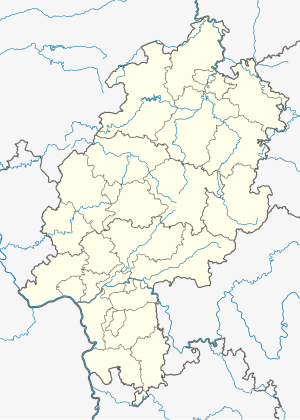Arbitration tunnel
| Arbitration tunnel | ||
|---|---|---|
|
Northern tunnel entrance during renovation work in June 2008
|
||
| use | Road tunnel | |
| traffic connection | Differ | |
| place | Limburg on the Lahn | |
| length | 245 m | |
| vehicles per day | 30,000 | |
| Number of tubes | 2 | |
| cross-section | 450 m² | |
| Largest coverage | 2 m | |
| construction | ||
| building-costs | 47,000,000 DM | |
| start of building | 1975 | |
| completion | 1982 | |
| location | ||
|
|
||
| Coordinates | ||
| East portal | 50 ° 23 '5 " N , 8 ° 3' 53" E | |
| West portal | 50 ° 23 '8 " N , 8 ° 3' 42" E | |
The federal highways 8 ( Cologne - Frankfurt ) and 417 ( Nassau - Wiesbaden ) run through the Schiedetunnel in Limburg an der Lahn . He crosses under the station forecourt and the railway line . Around 30,000 vehicles pass through the tunnel every day. The Schiedetunnel has four lanes and structurally separate carriageways.
The tunnel has a length of 245 meters and a height of 4.50 meters. The trough sections in front of the tunnel are 54 meters and 160 meters long. The construction costs amounted to around 47 million DM (around 24 million euros) and were mainly borne by the Federal Republic of Germany and the Federal Railroad.
The first plans for a new through-town passage in the city were made in the 1920s when it became apparent that the Alte Lahnbrücke was no longer able to cope with the traffic. At that time, the highways still ran through the historic old town.
These plans were resumed in the 1950s. With a new traffic concept, the two level crossings were also to be removed. Initially the intention was to use an elevated road to guide traffic through the city. However, this variant met with widespread rejection. The more expensive tunnel was built for urban planning reasons. The then Federal Transport Minister Georg Leber ( SPD ) was one of the tunnel's sponsors .
With the construction of the New Lahn Bridge (Lichfield Bridge ), work began on the new through town from 1968. Construction work on the tunnel began with the groundbreaking on May 27, 1975. The tunnel was built using the cut-and-cover method. About 40 buildings were demolished for the tunnel. After around seven years of construction, the tunnel was ceremoniously opened to traffic on November 18, 1982 by the Federal Minister of Transport, Werner Dollinger ( CSU ).
The tunnel was extensively renovated in 2008 and 2009. At the same time the redesign of the station forecourt above took place .
literature
- Sascha Braun: 25 years of the Schiedetunnel . In: Nassauische Neue Presse . November 19, 2007, p. 16 .

